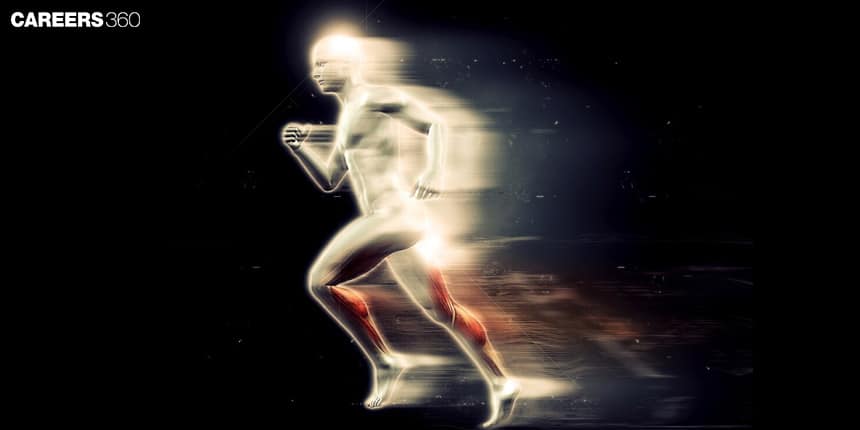Locomotion In Human Beings: Definition, Functions, Types, Importance, Topics
Locomotion is the way through which living organisms move or shift from one place to another to perform the most needed functions for survival and daily work. It is a central feature in finding food, escaping predators, finding shelter, and social interaction with other members of the same species. Indeed, locomotion has greatly defined our human evolution, including our build and behaviour, as well as shaping us to adapt to environmental conditions. This ability becomes basic for sustaining life or adjusting to new surroundings. This is one of the basic topics from chapter Locomotion and Movement chapter in Biology.
NEET 2025: Mock Test Series | Syllabus | High Scoring Topics | PYQs
NEET Important PYQ's Subject wise: Physics | Chemistry | Biology
New: Meet Careers360 B.Tech/NEET Experts in your City | Book your Seat now
- What is Locomotion?
- Structure of the Human Locomotor System
- Mechanism of Locomotion
- Neurological Control of Movement
- Factors Affecting Human Locomotion

What is Locomotion?
Locomotion is defined as the ability of an organism, which enables it to move from one place to another place that is in need for its existence and daily activities.
So, to enable an animal to move from place to place, it is of the essence for the human activity intending to perform survival, to perform recreations like collecting food and escaping danger, and social contact, and has greatly influenced human evolution, especially the origin of human structure and behaviour.
Also Read:
Structure of the Human Locomotor System
The components of human locomotor systems are:
Skeleton and Muscles
The human skeletal system gives the body its framework and supports the muscles that are put into action for movement.
The human skeletal system and how it provides the framework and structural anchorage to the applied muscles.
Names the types of muscles involved: Muscles of the skeletal system, attached to various bones in the human body via tendons.
How the muscular system contracts and relaxes: A muscle has actin and myosin filaments that slide past each other.
Joints
Joints play a role in the movement at the juncture of bones and provide the necessary flexibility and range of motion.
Types of joints: Ball-and-socket joint(hip joints), hinge joint (knee joints), pivot joint, etc.
Role of Joints in Movement:
They allow various movements like flexion-extension, rotation, etc. depending upon type and location.
For example, the ball-and-socket hip joint allows the movements of flexion-extension, rotation and circumduction of the lower limb.
Mechanism of Locomotion
Understanding how we move means studying the detailed mechanisms underlying different modes of locomotion.
Walking
Walking is the most common basic mode of human locomotion, relating to precision biomechanical processes.
Muscular and skeletal adaptations: Foot arch structure, tendons elastic energy storage.
Energy expenditure: Calculations of burnt calories per mile of walking.
Running
Running is different from walking by being done at a higher speed and mechanics, which puts more energy and the need for extra effort into the muscles.
With higher speed, the aerial phase pays the way for each stride.
Impacts on joints and muscles: Higher loads on joints, changes in muscle fibre types (fast-twitch).
Biomechanical efficiency: The influence of stride length and stride rate upon running economy.
Other Modes of Locomotion
Humans show versatility in movement rather than walking on the surface of the land. Humans have adapted to walking on water, including climbing.
Swimming: Buoyancy, streamlined body shape, and different stroke techniques.
Climbing: Gripping adaptations of hands and feet, muscular strength required for vertical movement.
Neurological Control of Movement
The nervous system plays a very important role in movements including coordination and regulation, concerning both reflex and voluntary movements.
Role of the central nervous system (CNS): Brain and spinal cord in control of voluntary and involuntary movements.
Reflex movements: instinctual reactions to stimuli, not requiring thought consciousness.
Voluntary motions: controlled and coordinated conscious brain mechanisms to begin and regulate.
Factors Affecting Human Locomotion
With growth, maturity, and ageing processes, human beings have their locomotion undergo several drastic changes.
Changes across the Lifespan: Developmental Stages Influencing Motor Skills.
Effects of ageing: loss in muscle mass, joint flexibility, and reaction times.
Injuries and disorders can affect locomotion and hence mobility and quality of life.
Common Injuries: Sprains (injuries to the ligaments), fractures (breaks in the bones) and their effects on mobility.
Disorders include but are not limited to rheumatoid and osteoarthritis, Parkinson's disease, and neurodegenerative disorders affecting motor control.
Also Read:
Recommended Video On ‘Locomotion In Human Beings’
Frequently Asked Questions (FAQs)
Human joints mainly consist of ball-and-socket, hinge, and pivot joints (hip, knee, and neck), respectively, for locomotion in different ways.
The skeletal system supports the structure of the body, protects important organs, and is an area for muscle attachment for movement.
Walking and running are based on energy-efficient transfers, leverage via bones and joints, and elastic recoil in tendons to keep the energy expenditure to a minimum.
They decrease muscle mass, joint flexibility, and reflexes slowing down, which, in turn, affects mobility and one's gait.
Voluntary movements are prompted in the cerebral cortex of the brain. The actions are transmitted as well as coordinated by the spinal cord and peripheral nerves.
Also Read
30 Nov'24 06:17 PM
28 Nov'24 05:27 PM
28 Nov'24 04:14 PM
28 Nov'24 03:07 PM
28 Nov'24 03:06 PM
28 Nov'24 01:21 PM
28 Nov'24 12:16 PM